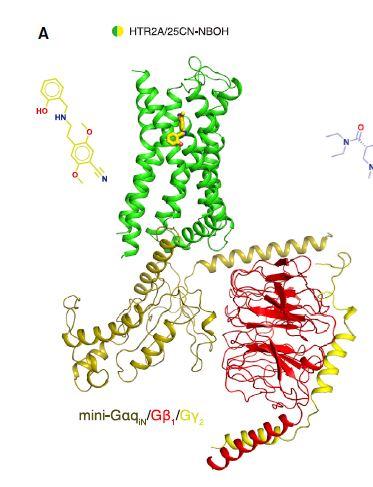
Credit: Kim et al./Cell
Although hallucinogenic drugs have been studied for decades, little is known about the underlying mechanisms in the brain by which they induce their hallucinogenic–and (for disorders like depression and anxiety) potential therapeutic–effects. A paper publishing September 17 in the journal Cell reveals the first X-ray crystallography structure of LSD bound to its target in the brain, the serotonin receptor. The paper also includes the first cryo-electron microscopy (cryo-EM) structure of a prototypical hallucinogen coupled with the entire serotonin receptor complex.
“Millions of people have taken these drugs recreationally, and now they’re emerging as therapeutic agents,” says senior author Bryan Roth, a professor in the Department of Pharmacology at the University of North Carolina School of Medicine. “Gaining this first glimpse of how they act at the molecular level is really, really important, and it’s key to understanding how they work.”
Scientists believe that activation of the 5-HT2A serotonin receptor (HTR2A) in the brain is essential to the effects of hallucinogenic drugs. “These receptors are expressed at very high levels in the human cerebral cortex,” Roth says. “When they’re activated, they cause neurons to fire in an asynchronous and disorganized fashion, putting noise into the system. We think that’s one of the reasons they cause a psychedelic experience. However, it’s not at all clear how they exert their therapeutic actions.”
In this study, Roth collaborated with Georgios Skiniotis, a structural biologist at the Stanford University School of Medicine. “A combination of several different advances allowed us to do this research,” Skiniotis says. “One of these is better, more homogeneous preparations of the receptor proteins. Another is the evolution of cryo-EM technologies, which allows us to obtain high-resolution structures of complexes without having to crystalize them.”
In the paper, the investigators revealed the first X-ray crystallography structure of LSD bound to HTR2A. In addition, cryo-EM was used to uncover images of a prototypical hallucinogen, called 25-CN-NBOH, bound together with the entire receptor complex, including the effector protein Gαq. In the brain, this complex modulates the release of neurotransmitters and influences many biological and neurological processes.
Roth, a psychiatrist and biochemist, leads the Psychoactive Drug Screening Program, funded by the National Institute of Mental Health. This gives him access to hallucinogenic drugs for research purposes. Normally, these compounds are difficult to study in the lab because they’re regulated by the Drug Enforcement Agency as Schedule 1 drugs.
“One of the main goals of my work is to understand how hallucinogens exert their actions on the brain,” Roth says. “If we can understand how they work at the molecular level, this will ultimately give us clues into human consciousness, perception, and awareness.”
Going forward, the investigators plan to apply their findings to structure-based drug discovery for new therapeutics. One of the goals is to discover potential candidates that may be able offer therapeutic benefit without the psychedelic effects.
“The more we understand about how these drugs engage and activate the receptors, the better we’ll understand their signaling properties,” Skiniotis says. “This work doesn’t give us the whole picture yet, but it’s an important piece of the puzzle.”
###
This work was funded by the National Institutes of Health, a cooperative agreement from the Defense Advanced Research Projects Agency, the National Cancer Institute, and the National Institute of General Medical Sciences.
Cell, Kim et al. “Structural insights into hallucinogen activation of 5-HT2A Serotonin Receptors” https://www.cell.com/cell/fulltext/S0092-8674(20)31066-7
Cell (@CellCellPress), the flagship journal of Cell Press, is a bimonthly journal that publishes findings of unusual significance in any area of experimental biology, including but not limited to cell biology, molecular biology, neuroscience, immunology, virology and microbiology, cancer, human genetics, systems biology, signaling, and disease mechanisms and therapeutics. Visit: http://www.
Media Contact
Carly Britton
[email protected]
Related Journal Article
http://dx.




